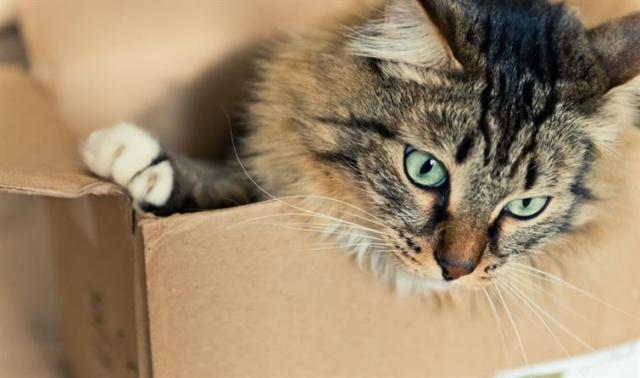Congrats on your big move! Moving into a new apartment is exciting. But with moving day comes a few stressors, especially if you have a pet(s). Moving with a pet is taxing – there's no doubt about it. Packing and unpacking is often a long, daunting process, especially if you have heavy furniture and an apartment full of belongings. And as much as cats like to play in moving boxes, they can't be moved in them with the rest of your things.
You don't want your pet to be stressed, confused, or in the way on moving day. And once you move in, you want them to feel at home and happy. To make this process as easy for both of you as possible, let's go over some tips for moving with pets and helping your pet acclimate to your new home – a step-by-step guide.
Prepare Your Pet for the Move
Before the actual move, getting your pet accustomed to change is important. First, start by leaving their carrier or crate out for them to explore. You can also take short car rides with them to help them get used to the sensation of travel. If your pet seems anxious, you should take them to the vet to see if they have any solutions.
Maintain Familiarity
When packing up, keep some of your pet's favorite toys, bedding, food, and bowls easily accessible. This will provide them with familiarity amidst the chaos of moving.

Choosing a Pet-Friendly Apartment
Next, you need to find the perfect place for you and your beloved pet(s):
1. Choose a pet-friendly apartment community. The first (and most important) step to preparing for a move with your furry friend happens long before moving day. It starts with choosing your next pet-friendly apartment. Don't overlook the word pet-friendly here, renters! If you anticipate bringing your pet with you on your move (of course you do), you must find a pet-friendly apartment. Lucky for you, there are plenty to choose from.
2. Filter your search. If you're using Apartments.com, filter your search for pet-friendly apartments only. If an apartment community is pet-friendly, they typically allow dogs and cats (along with other small animals – within reason), with the addition of pet fees/deposits, pet rent, breed restrictions, weight restrictions, and limitations on the number of pets per apartment. But don't let all these guidelines deter you – they're just to keep the community a happy and healthy environment for all tenants (and their pets). For instance, things may get a little out of hand if you have four cats, three dogs, one bird, and two fish in your two-bedroom apartment. And it wouldn't be fair for your neighbors (or your pets) to be cramped in one apartment that feels more like a petting zoo than a home.
3. Check the lease for the apartment's official pet policy. After you find an apartment you like, check with the property manager to see what additional fees or restrictions (if there are any) you'll need to know before signing a lease. And be sure to ask about any on-site or nearby pet amenities, such as a dog park or pet spa. Remember, it's common for apartment communities to ask for proof of vaccinations or even meet your furry friend (a pet interview) before you move in – so be prepared!

If You're Moving Locally with a Pet...
Moving with your pet shouldn't be too difficult if you're only moving down the street or to a nearby neighborhood. Here's what you can do to make this local move work for your pet:
1. Keep your pets away from the moving process. If possible, have a friend or family member who lives nearby watch your cat or dog for the day while you move into your new apartment. This way, your pet will have a nice day away from all the stress of moving. If this isn't possible for you, it's best to leave your pet at your current apartment rather than bring them to the new apartment while all your belongings are being brought in. If you have a friend or family member willing to stay with the pet at your old apartment while you move into your new apartment, then this is also an option. It's best not to leave the pet alone during the move, especially since they will be confused as to what is happening and why everything you own is gone – you don't want them thinking they're getting left behind! It's nice to have friends help you move, but your dog or cat will also appreciate some company while you move into your new place.
2. Transport them in your vehicle. When bringing your pet to your new place, bring them in your car. It's best not to take them in the U-Haul with you or in an unknown car (a friend or family member's car), especially if your pet is uneasy about change. Place them however you normally do in the car, whether in their carrier or the backseat – safety first, though.
3. Set up some things before taking your pet to the new apartment. Try not to bring your pet into the apartment before you've moved everything in. This will likely confuse your pet. Because you want them to feel as at home there as you do, you want the apartment to be set up, at least one room, before letting the pet into the apartment. This way, there won't be so much clutter or confusion.
4. Have your pet's belongings set aside. When your pet comes into the apartment, make sure their belongings are easily accessible – food, water, bed, toys, treats, etc. This will make them feel more at home, and it'll be easier for you when the feeding time comes.
5. Pet-proof the apartment. There will typically be hazardous items lying around, such as hammers, screws, nails, and more, when moving in – you'll likely be hanging curtains, pictures, etc. Pet-proof your apartment before you bring them into their new home! You don't want anything lying around that may hurt them and deter them from feeling comfortable in the apartment. Pets are sensitive to change, just like you!

If You're Moving Long-Distance with a Pet...
Long-distance moving can be a bit tricky, especially for your pet. There may be a few extra precautions you need to take if you're moving long-distance:
1. Contact your vet for any prescription medication your pet may need for the trip. If there's an extreme circumstance that is vet-approved, such as your cat's anxiety during car rides, then you may want to contact your vet to ensure you have the necessary medication to get your pet through the move. You'll also want to ensure you have all the paperwork (a list of recent vaccinations) for your pet, along with a tag for their collar with your new address on it.
2. Ensure the pet is secured in the proper carrier in your vehicle. If you are driving a long distance, be sure that small dogs and cats are comfortably in their carriers and buckled in the back seat. Large dogs should be crated in the back of the vehicle – if your vehicle has enough space. However your pet is situated, be sure they are comfortable and ready for the ride! If you don't want your pet to be in the way while you move in, try finding a kennel ahead of time, or keep your pet with a friend or family member in your new locale and pick them back up after you've moved in – whatever works best for both you and your furry friend.
3. If you're traveling by air, follow proper regulations. There are quite a few rules and regulations for flying with pets. Be sure to check with the airline you are traveling with to see their policy on flying with pets. However, some pets are better off traveling by vehicle, so always do what is best for your pet during the moving process.
4. Find a pet-friendly hotel room ahead of time. If you're driving a long distance to get to your new apartment in a new city, it's a good idea to go ahead and book a pet-friendly hotel room to stay in overnight. Stay on top of things to make this trip as painless as possible.
5. Do not let your pet out until you are in the apartment. Even if you have a pet who is obedient and used to being outdoors or off the leash, do not let them free until they are in the apartment. If they get lost, they don't know the area, nor do you – avoid this stressful scenario!
6. Give them time to adjust. The most important thing to remember is that your pet has to adjust to this home just like you will. After their belongings are in the apartment and the smell becomes familiar, they'll be just as happy there as you.

If your pet is still having issues acclimating…
-
Stick to a Routine
Pets thrive on routines, so try to maintain their feeding, playtime, and bathroom schedules as closely as possible. This consistency will help them feel more secure during this transition period.
-
Positive Association
Associate positive experiences with the new apartment by offering treats, praise, and affection when your pet displays good behavior or explores new areas. This will help them associate the new space with positive emotions.
-
Quality Time Together
During this adjustment period, engage in activities your pet loves. Play, grooming, and cuddling will help strengthen your bond and reassure your pet that they are safe and loved.
-
Addressing Unfamiliar Sounds
Apartments often come with different sounds compared to a previous living situation. Gradually introduce your pet to these sounds by exposing them in a controlled manner while providing comfort and positive reinforcement.
-
Seek Professional Help if Necessary
If your pet struggles significantly with the transition, consider seeking advice from a professional animal behaviorist. They can offer personalized strategies to address your pet's specific needs.
Moving with pets can be stressful, but remember, this is an exciting time! If done right, the moving process will be easy peasy, and your pet will love your new apartment just as much (if not more) than the last!






